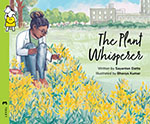
THE PLANT WHISPERER
Shivani Bajaj
This book is based on the true story of Dr. H Jaishree Subrahmaniam, who has done some amazing research based on mustard plants. She studied in India, New York and then France. Jaishree shifted from studying engineering to studying plants because she felt closer to them and was intrigued by their behaviour and their world. A true plant lover, she believes and has shown that plants help each other in times of stress and pressures. She also goes on to say that there is so much humans can learn from this behaviour of plants! The book gives us a window into Jaishree’s world—both professional and a bit of personal. As a child, she was sensitive, loved climbing up trees and being close to plants and nature in her grandmother’s garden. Even after growing up, she fondly remembers a tree that was her ‘friend’. In fact, her interest in plants emanates from those childhood associations which left an impact on her. Very simply written, minimally expressed and matter of fact, the story even appears to be somewhat sketchy, but then we can understand the entire story needs to be told, so details cannot be the strong point. In fact, the questions in her mind and where and how she pursues them, seem to form the mainstay of the book. Sayantan Datta has a keen interest in science and dabbles in the sphere of science communication. His experience of writing for children is new. Sometimes, in trying to keep the story short, simple and in trying to cater to a certain kind of reader, the author has to compromise on storytelling. This is a Level 3 Pratham book and hence not meant for proficient readers. There could have been more about Jaishree’s early life and growing up years, to draw the interest of the young readers and it could have been made into a level 4 book, while telling the story better. The illustration on the cover warms the heart as Jaishree sits beside her mustard plants as one would sit among friends. Other illustrations by Bhavya Kumar, especially those of birds and animals on the trees, add life to the book. All said and done, it is an unusual subject for a book and a much neglected one as well. Women scientists are ignored, and their stories are hidden from the world. To top that, we have an ‘Indian’ woman scientist. The author has done a great job of bringing this story to light, that too for our young readers. This ensures children get to know about them and also be inspired by them to pursue science, even though it might not be the first choice for most girls in certain sections of India, even today. The book for that reason deserves its place in the Parag Honour List 2023. by By Sayantan Datta. Illustrations byBhavya Kumar Pratham Books, 2022, 24 pp., INR 85.00
This book is based on the true story of Dr. H Jaishree Subrahmaniam, who has done some amazing research based on mustard plants. She studied in India, New York and then France. Jaishree shifted from studying engineering to studying plants because she felt closer to them and was intrigued by their behaviour and their world. A true plant lover, she believes and has shown that plants help each other in times of stress and pressures. She also goes on to say that there is so much humans can learn from this behaviour of plants!
The book gives us a window into Jaishree’s world—both professional and a bit of personal. As a child, she was sensitive, loved climbing up trees and being close to plants and nature in her grandmother’s garden. Even after growing up, she fondly remembers a tree that was her ‘friend’. In fact, her interest in plants emanates from those childhood associations which left an impact on her.
Very simply written, minimally expressed and matter of fact, the story even appears to be somewhat sketchy, but then we can understand the entire story needs to be told, so details cannot be the strong point. In fact, the questions in her mind and where and how she pursues them, seem to form the mainstay of the book.
Sayantan Datta has a keen interest in science and dabbles in the sphere of science communication. His experience of writing for children is new. Sometimes, in trying to keep the story short, simple and in trying to cater to a certain kind of reader, the author has to compromise on storytelling. This is a Level 3 Pratham book and hence not meant for proficient readers. There could have been more about Jaishree’s early life and growing up years, to draw the interest of the young readers and it could have been made into a level 4 book, while telling the story better.
The illustration on the cover warms the heart as Jaishree sits beside her mustard plants as one would sit among friends. Other illustrations by Bhavya Kumar, especially those of birds and animals on the trees, add life to the book.
All said and done, it is an unusual subject for a book and a much neglected one as well. Women scientists are ignored, and their stories are hidden from the world. To top that, we have an ‘Indian’ woman scientist. The author has done a great job of bringing this story to light, that too for our young readers. This ensures children get to know about them and also be inspired by them to pursue science, even though it might not be the first choice for most girls in certain sections of India, even today. The book for that reason deserves its place in the Parag Honour List 2023.

